30+ Best Web Tools to Get Things Done
Are you tired of juggling multiple tasks, struggling to stay organised, and feeling overwhelmed by your never-ending to-do list? Well, worry no more! In this fast-paced digital world, we're lucky to have many web tools to help us easily tackle our daily tasks. Whether you're a student, a professional, an entrepreneur, or someone looking to streamline your life, I have some exciting news. In this blog post, I'll share over 30 incredible web tools guaranteed to supercharge your productivity and help you get things done like a boss.
But before we dive into the treasure trove of excellent tools, let's take a moment to understand the importance of productivity in our lives. Did you know that according to a recent study, the average person spends nearly 4 hours daily on non-work-related tasks, like checking emails, social media, and other distractions? That's a whopping 20 hours a week or 1,040 hours a year wasted! Imagine what you could accomplish with that time if used more efficiently.
Luckily, the digital age has brought us various innovative tools designed to optimise our productivity and maximise our time. From project management platforms to collaboration tools, note-taking apps to time trackers, there's a web tool for every need and preference. In this post, I've carefully curated a list of the best ones based on user reviews, functionality, and popularity.
So, whether you're seeking a powerful task management system to keep your projects on track, a distraction-blocking tool to stay focused, or a virtual assistant to automate repetitive tasks, you'll discover some real game-changers. Get ready to revolutionise your workflow and unlock your true potential as we explore the top web tools that will transform how you get things done. Let's jump right in!
Table of Contents
Web Development Tools:
1 – Visual Studio Code

Visual Studio Code (VS Code) is a popular and highly versatile web development tool created by Microsoft. It is a lightweight, open-source source code editor that supports multiple programming languages and runs on various platforms like Windows, macOS, and Linux. With its extensive ecosystem of extensions, VS Code caters to the needs of developers across different domains.
One of the critical features of VS Code is its highly customisable user interface. Users can personalise the layout, themes, and keyboard shortcuts to suit their preferences, making it a comfortable environment for coding. The editor also offers an integrated terminal, allowing developers to execute commands without switching between applications.
VS Code provides robust editing capabilities, such as code autocompletion, syntax highlighting, and code refactoring tools. It supports Git version control, enabling seamless collaboration and easy management of code repositories. With IntelliSense, an intelligent code completion feature, developers receive suggestions and documentation in real-time, improving productivity and reducing errors.
The debugging functionality in VS Code simplifies the process of identifying and fixing issues in code. Developers can set breakpoints, inspect variables, and observe their code to understand its behaviour. Additionally, VS Code integrates with popular build systems and task runners, facilitating efficient project management and automation.
The robust extension ecosystem is one of the most significant strengths of VS Code. Developers can install extensions for specific languages, frameworks, and tools, enhancing the editor's capabilities. These extensions support linting, testing, code formatting, and more, making development workflows smoother and more efficient.
Overall, Visual Studio Code is a versatile web development tool that combines a lightweight yet feature-rich code editor with a customisable and extensible ecosystem. Its user-friendly interface, extensive language support, and integration with popular development tools make it a top choice for developers of all levels of expertise.
2 – GitHub

GitHub is a powerful web development tool, a version control system and a collaboration platform for developers. It enables teams to work together on projects efficiently and effectively. At its core, GitHub utilises Git, a distributed version control system, to manage and track changes in code repositories.
One of GitHub's key features is its repository hosting service, which allows developers to store, manage, and share their codebase. Each repository contains the entire project's history, including all revisions, branches, and commits. It provides a central hub where developers can collaborate, review code, and propose changes through pull requests.
GitHub's issue-tracking system is another valuable feature. It enables developers to create and manage tasks, bugs, and feature requests, fostering effective project management and communication among team members. Issues can be assigned, commented on, and labelled for easy organisation and prioritisation.
Additionally, GitHub offers extensive collaboration capabilities. Multiple developers can contribute to the same project simultaneously, with the ability to merge changes and resolve conflicts seamlessly. It provides a platform for code reviews, facilitating constructive feedback and ensuring the quality of the codebase.
GitHub supports various integrations and workflows through its extensive third-party tools and services ecosystem. It enables continuous integration and deployment through platforms like Jenkins or Travis CI, making automating build processes easier and ensuring code stability.
Furthermore, GitHub allows for community engagement through its social features. Developers can follow projects, star repositories, and contribute to open-source projects, fostering a vibrant ecosystem of knowledge sharing and collaboration.
3 – React

React is a popular JavaScript library for building user interfaces. Facebook developed it, and is widely used by developers to create dynamic and interactive web applications. React follows a component-based architecture, where the user interface is broken down into reusable and self-contained components.
One of the critical features of React is its virtual DOM (Document Object Model) implementation. Instead of directly manipulating the browser's DOM, React creates a virtual representation of the DOM, allowing it to efficiently update and render only the necessary components when there are changes. This results in improved performance and a smoother user experience.
React also employs a declarative approach to building UIs. Developers describe how the UI should look based on the current state, and React updates the UI when the state changes. This makes reasoning about the application's behaviour easier and simplifies managing complex UIs.
Another advantage of React is its robust ecosystem and extensive community support. It provides a vast collection of third-party libraries, tools, and frameworks, known as the React ecosystem, that enhance development capabilities and address common challenges. Some notable libraries include React Router for client-side routing, Redux for state management, and Styled Components for styling.
Furthermore, React can be used for both client-side and server-side rendering. With tools like Next.js, React applications can be pre-rendered on the server, improving initial load times and enabling better SEO.
4 – Angular

Angular is a popular web development framework created by Google. It is a comprehensive tool for building dynamic, single-page applications (SPAs) and cross-platform mobile applications. Angular follows the model-view-controller (MVC) architectural pattern and uses TypeScript, a JavaScript superset, as its primary programming language.
One of the key features of Angular is its ability to create responsive and interactive user interfaces. It provides a powerful templating system that allows developers to define the structure and behaviour of their applications using HTML templates combined with Angular-specific syntax. These templates can be easily extended and reused, facilitating the development process.
Angular also offers a modular approach to application development. It uses a concept called “modules” to organise and encapsulate different components, services, and other related resources. Modules help maintain a clean and scalable codebase by dividing the application into manageable and reusable units.
Another vital feature of Angular is its robust dependency injection system. It simplifies the management of dependencies between different components and services, making writing testable and maintainable code easier. Angular's dependency injection enables efficient decoupling and promotes code reusability.
Additionally, Angular provides a comprehensive set of tools and libraries for tasks such as routing, form handling, data binding, and animations. These built-in features often eliminate the need for external libraries, streamlining the development process and reducing the overall project size.
5 – Bootstrap

Bootstrap is a popular web development framework that simplifies creating responsive and visually appealing websites. It provides developers with pre-designed templates, CSS styles, and JavaScript components, enabling them to build websites quickly and efficiently.
One of the critical features of Bootstrap is its responsive grid system. It offers a fluid layout that automatically adjusts to different screen sizes, ensuring that websites look great on desktops, tablets, and mobile devices. This grid system consists of rows and columns, allowing developers to create flexible and responsive page layouts.
Another notable feature of Bootstrap is its extensive library of CSS classes and components. These pre-styled elements, such as buttons, forms, navigation menus, and typography styles, can be easily incorporated into web pages. Developers can customise these components to match their design requirements or use them as they are, saving significant development time.
Bootstrap also includes a variety of JavaScript plugins that enhance the functionality of web pages. These plugins offer interactive features like carousels, modals, tooltips, and dropdown menus. Developers can seamlessly integrate these plugins into their projects, enriching the user experience without writing complex JavaScript code from scratch.
Additionally, Bootstrap promotes consistency and design standards across different projects. By following its predefined style guidelines, developers can ensure a unified and professional look throughout their websites. Bootstrap also provides extensive documentation and community support, making it easier for developers to learn and troubleshoot any issues they may encounter.
6 – Figma
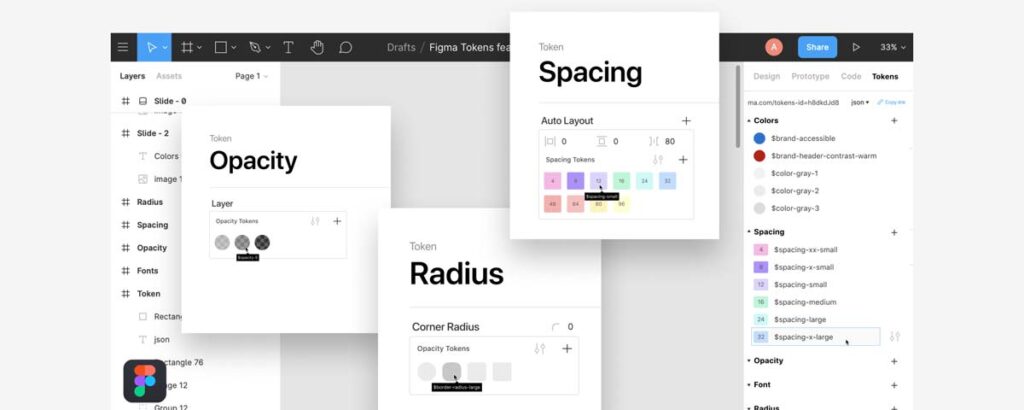
Figma is a powerful web development tool that revolutionises the way designers and developers collaborate on creating user interfaces. It is a cloud-based platform that enables real-time collaboration, making it easy for teams to work together seamlessly, regardless of their physical location.
One of Figma's standout features is its robust design editor, which allows users to create visually stunning and interactive prototypes. It provides a wide range of design tools, including vector editing, shape and text manipulation, and the ability to create reusable components and styles. These features promote consistency and efficiency throughout the design process.
Figma's real-time collaboration feature is a game-changer, as multiple team members can work on a project simultaneously. This allows instant feedback and eliminates the need for time-consuming file sharing or version control issues. Additionally, Figma offers a commenting system enabling users to provide feedback directly on specific design elements, facilitating clear communication and reducing misunderstandings.
Another critical aspect of Figma is its powerful prototyping capabilities. Designers can create interactive prototypes with transitions, animations, and micro-interactions, providing a realistic preview of the user experience. This helps stakeholders understand the design flow and enables developers to understand the intended functionality better.
Furthermore, Figma simplifies developer handoff by automatically generating CSS, Android XML, and Swift code snippets from design elements. This eliminates manual translation and speeds up the development process, ensuring accuracy and consistency between design and implementation.
Web Design Tools:
7 – Sketch
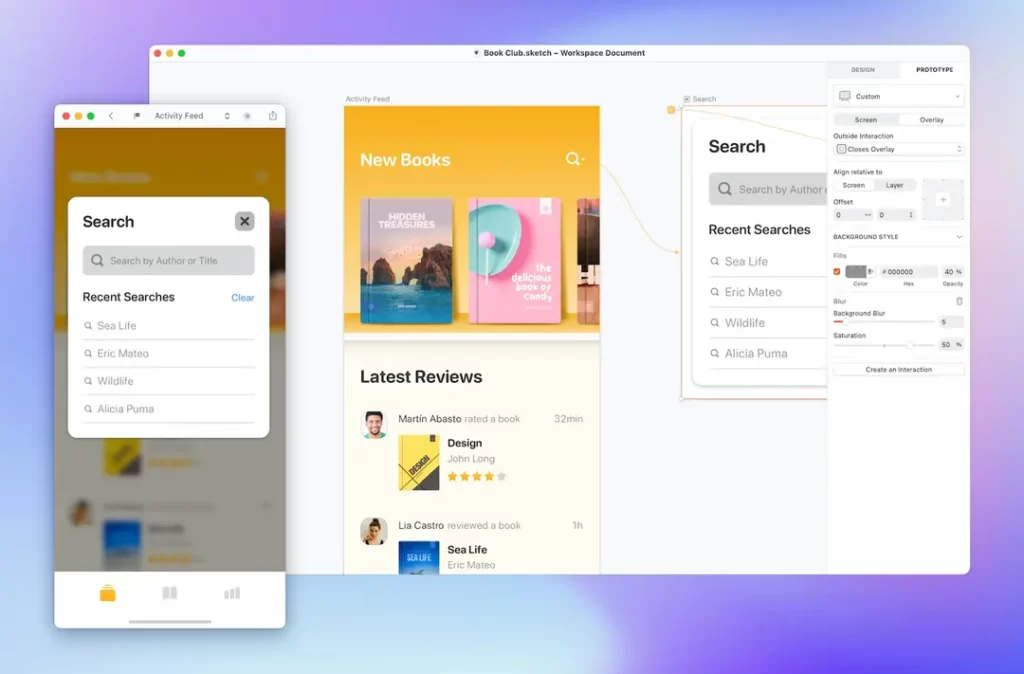
Sketch is a popular web design tool that empowers designers to create visually stunning and user-friendly interfaces for websites and applications. With a sleek and intuitive interface, Sketch has become a go-to choice for many professionals in the design industry.
One of the critical features of Sketch is its vector-based editing capabilities. Designers can easily create and manipulate shapes, icons, and illustrations using the powerful vector editing tools provided. This ensures the designs remain scalable and retain quality across different screen sizes and resolutions.
Another standout feature of Sketch is its comprehensive layout system. Designers can easily create artboards and define responsive layouts using grids, columns, and guides. This allows for precise alignment and positioning of elements, enabling designers to create pixel-perfect designs.
Sketch also offers an extensive library of plugins and integrations, further enhancing its functionality. These plugins provide additional tools and features, such as prototyping, collaboration, and asset management, allowing designers to streamline their workflow and improve productivity.
Furthermore, Sketch supports real-time collaboration, enabling multiple designers to work on a project simultaneously. This feature encourages seamless collaboration, feedback exchange, and version control, enhancing team efficiency and ensuring smooth project management.
8 – Adobe XD
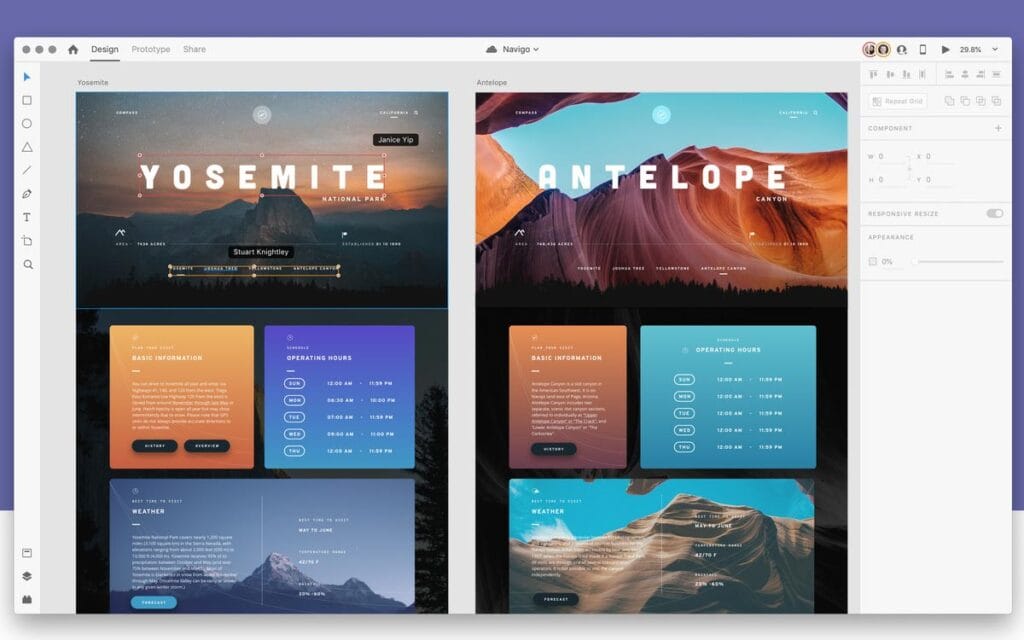
Adobe XD is a powerful web design tool that enables designers and developers to create interactive and visually stunning user interfaces (UI) and experiences (UX) for websites and mobile applications. With its intuitive interface and comprehensive feature set, Adobe XD has become a go-to tool for professionals in the field.
One of the standout features of Adobe XD is its robust prototyping capabilities. Designers can easily create interactive prototypes by linking different artboards together, allowing stakeholders to experience the flow and functionality of the design. This feature facilitates feedback and collaboration, ensuring the final product meets the client's requirements.
Another key feature is the ability to design responsive layouts. Designers can create designs that adapt seamlessly to different screen sizes and orientations, making it easier to develop websites and apps accessible across multiple devices.
Adobe XD also offers a vast library of UI kits, icons, and plugins, empowering designers to speed up their workflow. These resources provide a starting point for design elements, saving time and effort in the creation process.
Furthermore, Adobe XD integrates seamlessly with other Adobe Creative Cloud applications, such as Photoshop and Illustrator. This interoperability allows for a smooth workflow, enabling designers to import assets and collaborate with other team members effortlessly.
9 – Canva

Canva is a popular web design tool that empowers individuals and businesses to create visually stunning graphics, documents, and presentations without requiring extensive design skills. Launched in 2012, Canva has revolutionised how people approach graphic design by offering a user-friendly and intuitive platform that streamlines the design process.
One of Canva's standout features is its vast library of customisable templates. Users can choose from various professionally designed templates, such as social media posts, presentations, infographics, flyers, and more. These templates serve as a starting point, providing users with a foundation they can modify and personalise to match their needs.
Canva also provides a comprehensive selection of design elements and assets, including millions of stock photos, illustrations, icons, shapes, and fonts. Users can effortlessly drag and drop these elements onto their canvas, rearrange and resize them, and apply filters and effects to create visually appealing designs. Additionally, Canva allows users to upload and incorporate images into their designs.
Collaboration is another integral part of Canvas functionality. It enables multiple users to work simultaneously on a project, making it ideal for teams and businesses. With real-time editing and commenting features, team members can provide feedback, suggest changes, and collaborate seamlessly to produce high-quality designs.
Moreover, Canva offers various export options, allowing users to download their designs in different formats suitable for print or digital platforms. Users can save their designs as JPEG, PNG, PDF, or even animated GIFs, making it easy to share their creations online or offline.
10 – InVision Studio

InVision Studio is a powerful web design tool that empowers designers to create interactive and captivating user experiences. It combines the functionalities of a prototyping tool and graphic design software, offering a seamless workflow for designing and animating user interfaces.
One of the standout features of InVision Studio is its intuitive and user-friendly interface, which allows designers to bring their ideas to life quickly. Users can easily create wireframes, mockups, and high-fidelity designs with various design elements and components. The tool supports vector editing, allowing designers to create and precisely manipulate shapes, icons, and illustrations.
InVision Studio also excels in prototyping capabilities. Designers can define interactive transitions, gestures, and animations to create lifelike prototypes. The tool offers an extensive library of pre-built animations and allows users to create custom animations. This facilitates the communication of design concepts and interactions with clients, stakeholders, and development teams.
Collaboration is a crucial aspect of InVision Studio. Designers can share their prototypes with team members and gather feedback directly within the tool. This fosters a collaborative design process and streamlines communication, ensuring everyone is on the same page.
Furthermore, InVision Studio integrates with other popular design tools and platforms, making it compatible with existing workflows. It allows designers to import assets from tools like Sketch and Photoshop, enhancing flexibility and ease of use.
11 – Zeplin

Zeplin is a powerful web design collaboration and handoff tool that streamlines the process of converting design files into code. It bridges designers and developers, facilitating seamless communication and efficient collaboration throughout the design and development cycle.
One of Zeplin's key features is its ability to generate style guides automatically. Designers can upload their design files, and Zeplin extracts all the necessary information, including colours, typography, spacing, and dimensions. This eliminates the need for designers to create manual style guides, saving them valuable time and effort.
Moreover, Zeplin simplifies the process of inspecting and exporting design assets. Developers can directly access design specifications such as CSS code snippets, colour values, and measurements from Zeplin. This ensures accuracy and reduces the chances of misinterpretation, resulting in faster implementation.
Another notable feature of Zeplin is its commenting system. Designers and developers can leave comments directly on specific design elements, providing contextual feedback and facilitating discussions. This feature enhances collaboration and eliminates the need for lengthy email chains or confusing document versions.
Additionally, Zeplin offers integrations with popular design tools like Sketch, Adobe XD, and Figma, allowing seamless importing of design files. This compatibility ensures that designers can continue using their preferred design software while leveraging the benefits of Zeplin's collaboration features.
Content Management Systems (CMS):
12 – WordPress

WordPress is a powerful and widely-used content management system that provides users with a flexible platform for creating and managing websites. It was initially developed as a blogging platform but has evolved into a full-fledged CMS with extensive features and capabilities.
One of the critical strengths of WordPress is its user-friendly interface, which allows individuals with minimal technical expertise to build and maintain websites. It offers a range of customisable themes, allowing users to change the look and feel of their websites effortlessly. Additionally, WordPress provides a wide array of plugins, which are add-on modules that enhance the functionality of the CMS. These plugins enable users to extend the core features of WordPress, such as adding contact forms, search engine optimisation tools, e-commerce functionality, and much more.
Another notable feature of WordPress is its robust content management system. Users can easily create and edit posts and pages and organise their content using categories and tags. WordPress also supports multimedia integration, allowing users to easily add images, videos, and audio files to their websites.
WordPress is highly scalable and can handle websites of all sizes, from personal blogs to large corporate websites. It is also optimised for search engine visibility, providing features like customisable permalinks, meta tags, and XML sitemaps, contributing to better rankings.
Moreover, WordPress has a thriving community of developers, designers, and users who contribute to its growth. This community ensures regular updates, security patches, and a vast resource of themes, plugins, and support forums.
13 – Drupal

Drupal is a powerful and flexible CMS renowned for its robustness and scalability. It empowers individuals and organisations to build and manage websites and applications of all sizes and complexities. With a vibrant community and extensive module ecosystem, Drupal offers a range of features that make it a popular choice for developers and content creators.
One of Drupal's key strengths is its flexibility. It provides a highly modular architecture, allowing users to customise and extend its functionality to meet specific requirements. The core features of Drupal include content creation and editing, user management, and menu and taxonomy management. It offers a WYSIWYG editor for easy content creation and a flexible system for organising content through categories and tags.
Drupal also excels in handling large amounts of data and high-traffic websites. It supports caching mechanisms and has built-in tools for optimising performance. Additionally, Drupal offers excellent security features, with regular updates and a dedicated security team to address vulnerabilities promptly.
Another standout feature of Drupal is its multilingual capabilities. It provides robust support for creating and managing content in multiple languages, making it an ideal choice for international websites.
Furthermore, Drupal offers a wide range of modules and themes from its active community. These extensions enable users to enhance their websites with features like e-commerce, forums, social media integration, and more. The community actively maintains and updates these modules, ensuring compatibility and security.
14 – Joomla

Joomla is a robust and popular CMS that enables users to build and manage dynamic websites and online applications. With its user-friendly interface and powerful features, Joomla has become a favoured choice for individuals, small businesses, and large enterprises.
One of Joomla's standout features is its flexibility. It offers many templates and extensions, allowing users to customise their websites to meet specific requirements. Whether it's a personal blog, eCommerce store, or corporate website, Joomla can adapt to various needs and industry verticals.
Joomla excels in its content management capabilities. It provides a hierarchical organisation system for content, making it easy to create, edit, and categorise articles, blog posts, images, and videos. The built-in WYSIWYG editor simplifies content creation, enabling non-technical users to manage their websites effortlessly.
Additionally, Joomla offers a robust user management system, allowing administrators to create multiple user groups with different access levels. This feature is handy for collaborative websites or sites with multiple contributors.
Furthermore, Joomla is known for its extensibility. The Joomla Extensions Directory offers thousands of extensions, including plugins, modules, and components, which enhance the functionality of Joomla websites. These extensions cover many features, including social media integration, SEO optimisation, eCommerce capabilities, event management, etc.
Joomla also emphasises security. It has a dedicated security team that actively addresses vulnerabilities and releases regular updates to ensure a secure user environment. Its access control features and user permission settings further enhance website security.
SEO and Marketing Tools:
15 – Google Analytics

Google Analytics is a powerful web analytics tool offered by Google that provides detailed insights and data about website traffic and user behaviour. It allows website owners, marketers, and analysts to track, measure, and analyse various aspects of their performance. With its extensive features, Google Analytics helps users make informed decisions to optimise their online presence and improve their business outcomes.
One of the key features of Google Analytics is its ability to track website traffic and provide information about the number of visitors, their geographic location, and the sources that led them to the website. This helps users understand the effectiveness of their marketing campaigns and identify the channels that drive the most traffic.
Additionally, Google Analytics offers in-depth data on user behaviour, allowing users to analyse how visitors navigate their website, visiting pages, and actions. This information helps identify areas of improvement, optimise website design, and enhance user experience.
The tool also provides:
- Data on conversions and goals.
- Enabling users to track specific actions taken by visitors, such as purchases.
- Form submissions.
- Newsletter sign-ups.
This feature helps measure the effectiveness of marketing efforts and assess the overall success of a website's objectives.
Google Analytics offers customisable reports and real-time data, empowering users to create customised dashboards, set up automated alerts, and visualise data through graphs and charts. This flexibility allows users to monitor key metrics and track performance over time.
Furthermore, Google Analytics seamlessly integrates with other Google products, such as Google Ads and Google Search Console, providing a comprehensive view of digital marketing efforts and enabling users to make data-driven decisions.
16 – SEMrush

Semrush is a powerful web tool designed for digital marketers, SEO professionals, and content creators to optimise their online presence and improve search engine rankings. It offers a comprehensive suite of features enabling users to conduct in-depth keyword research, analyse competitively, and track their website's performance.
One of Semrush's key features is its keyword research tool. It allows users to identify relevant keywords related to their industry, discover search volume and trends, and assess keyword difficulty. This information helps marketers understand what keywords to target and optimise their content accordingly.
Competitive analysis is another crucial aspect of Semrush. Users can analyse their competitors' online strategies, including organic and paid search, backlink profiles, and top-performing content. This insight allows businesses to fine-tune their strategy, identify gaps, and gain a competitive edge.
Semrush also offers a site audit feature that scans websites for technical SEO issues, providing actionable recommendations for optimisation. It helps improve website performance, user experience, and search engine visibility.
In addition, Semrush provides a backlink analysis tool, allowing users to monitor their backlink profile, identify toxic links, and discover new link-building opportunities. This helps improve the website's authority and credibility in search engine algorithms.
Furthermore, Semrush offers social media tracking and content marketing tools, enabling users to plan, create, and distribute engaging content across various platforms. It provides valuable insights into social media performance and helps marketers track their content's reach and engagement.
17 – Ahrefs
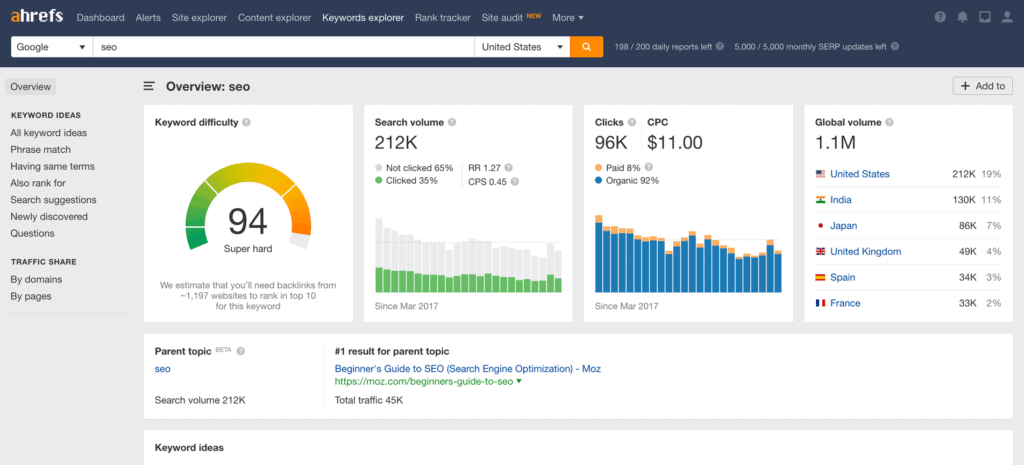
Ahrefs is a powerful web tool for SEO (Search Engine Optimisation) and digital marketing professionals. It provides a comprehensive suite of features and data that assist in analysing, optimising, and improving website visibility and organic search rankings.
One of the primary features of Ahrefs is its backlink analysis. It allows users to explore and evaluate the backlink profiles of websites, including their quantity, quality, and referring domains. This information is crucial for understanding a website's authority and devising effective link-building strategies.
Ahrefs also offers keyword research capabilities. Users can find valuable insights into keyword search volumes, difficulty levels, and related keyword suggestions. This information helps identify the most relevant and lucrative keywords to target, optimise content, and improve organic search rankings.
The tool provides a comprehensive Site Audit feature that scans websites for potential issues affecting SEO performance, such as broken links, duplicate content, or slow page load times. By addressing these issues, users can enhance website crawlability, user experience, and overall search engine visibility.
Ahrefs' Content Explorer lets users discover popular content related to specific topics or keywords. It helps identify trending issues, analyse competitors' content strategies, and find opportunities to create high-quality and engaging content.
Another notable feature is the Rank Tracker, which allows users to monitor their website's rankings for specific keywords across different search engines and locations. This feature provides valuable data to evaluate the effectiveness of SEO efforts and make informed decisions for optimisation.
18 – MailChimp

Mailchimp is a versatile and widely-used web tool that empowers businesses and individuals to create, manage, and optimise email marketing campaigns. With a user-friendly interface and comprehensive features, Mailchimp has become a go-to platform for organisations of all sizes.
One of Mailchimp's primary functions is email campaign creation. It offers a variety of customisable templates that allow users to design professional and visually appealing newsletters and emails without any coding knowledge. Users can easily add images, text, and call-to-action buttons to create engaging content.
Mailchimp provides robust email list management capabilities. Users can import existing email lists or build new ones from scratch, segmenting subscribers based on specific criteria. This segmentation feature enables targeted marketing, allowing users to tailor their messages to different audiences, leading to higher engagement and conversion rates.
The platform offers automation features that help streamline marketing efforts. Users can set up automated email sequences triggered by specific events or actions, such as welcoming new subscribers, sending follow-up emails, or delivering personalised recommendations based on user behaviour. This feature saves time and ensures consistent communication with subscribers.
Mailchimp's analytics and reporting features allow users to track and measure the success of their email campaigns. Users can access data on open rates, click-through rates, subscriber growth, and other vital metrics. These insights provide valuable feedback to optimise future campaigns and improve marketing strategies.
Furthermore, Mailchimp offers integrations with third-party tools, such as e-commerce platforms, CRM systems, and social media platforms. This integration capability allows users to synchronise their data, automate workflows, and extend the reach of their marketing efforts across different channels.
19 – Hootsuite

Hootsuite is a powerful web tool that simplifies social media management for individuals and businesses. It offers various features to help users manage and optimise their social media presence across multiple platforms. With its user-friendly interface, Hootsuite allows users to monitor, schedule, and analyse their social media activities all in one place.
One of the critical features of Hootsuite is its social media scheduling functionality. Users can create and schedule posts in advance, allowing them to maintain a consistent presence on platforms like Facebook, Twitter, Instagram, LinkedIn, and more. This feature enables efficient content planning and saves time by automating the publishing process.
Hootsuite also provides comprehensive social media monitoring capabilities. Users can track mentions, comments, and interactions on their posts, enabling them to engage with their audience effectively. The tool offers customisable streams that aggregate all social media activity into one dashboard, allowing users to monitor their brand's reputation, stay updated with industry trends, and promptly respond to customer queries or concerns.
Furthermore, Hootsuite offers social media analytics to measure the performance of social media campaigns. Users can access detailed reports that provide insights into key metrics such as engagement, follower growth and reach. These analytics help users understand their audience, identify successful strategies, and make data-driven decisions to optimise their social media efforts.
Additionally, Hootsuite supports team collaboration, allowing multiple users to manage social media accounts simultaneously. This feature streamlines workflows and facilitates seamless communication within teams.
eCommerce Tools:
20 – Shopify

Shopify is an advanced eCommerce platform enabling entrepreneurs and businesses to create and manage online stores. With an intuitive interface and a wide array of features, Shopify empowers users to build professional-looking, customisable websites without coding or technical expertise.
At its core, Shopify offers essential eCommerce functionalities, such as product management, inventory tracking, and order processing. Users can effortlessly add and categorise products, set prices, and showcase high-quality images. The platform also provides inventory management tools that notify merchants when stock is low or out of stock, ensuring smooth operations.
Shopify incorporates numerous features to enhance the online shopping experience. It offers a variety of professionally designed themes and templates that can be customised to match a brand's identity. Additionally, the platform integrates with multiple payment gateways, allowing customers to make secure transactions using their preferred methods.
Moreover, Shopify simplifies the process of managing customer relationships. It includes tools for email marketing, customer segmentation, and personalised promotions. The built-in analytics feature gives merchants valuable insights into their store's performance, including sales trends, customer behaviour, and traffic sources.
The platform goes beyond just selling products online. It offers functionalities to trade in physical locations, pop-up shops, and social media channels. Shopify integrates seamlessly with various third-party apps and services, enabling users to extend their store's capabilities with additional features like advanced marketing tools, accounting software, and inventory management systems.
To ensure a smooth user experience, Shopify provides 24/7 customer support through various channels, including live chat, email, and phone. Additionally, the platform offers a robust knowledge base and an active community forum where users can find answers to their queries and connect with fellow entrepreneurs.
21 – WooCommerce

WooCommerce is a powerful and popular eCommerce tool that enables individuals and businesses to create and manage online stores efficiently. It is a plugin built for WordPress, a widely used content management system. WooCommerce provides comprehensive features and customisation options, making it a versatile solution for selling products and services online.
One of WooCommerce's key features is its user-friendly interface, which simplifying setting up an online store. Users can install the plugin, configure their store settings, and add products with just a few clicks. WooCommerce offers a range of customisable themes and design options, allowing users to create visually appealing and branded storefronts that align with their business identity.
The platform supports various product types, including physical goods, digital downloads, and affiliate products. Users can easily manage inventory, track stock levels, and configure shipping options. Flexible pricing options, such as fixed prices, tiered pricing, and discount coupons, enable businesses to implement effective sales strategies.
WooCommerce includes built-in payment gateway integrations, enabling seamless transactions. It supports popular payment processors like PayPal, Stripe, and Square and offline payment methods like bank transfers and cash on delivery.
Additionally, WooCommerce provides comprehensive reporting and analytics tools. Store owners can track sales, customer behaviour, and product performance to gain insights and make data-driven decisions. The plugin also offers a range of extensions and integrations, allowing users to enhance their store's functionality with additional features such as subscriptions, memberships, and marketing tools.
22 – Stripe

Stripe is a robust and widely used eCommerce tool that provides businesses with comprehensive features to handle online payments and transactions. Founded in 2010, Stripe has become a popular choice for companies of all sizes due to its simplicity, flexibility, and developer-friendly design.
At its core, Stripe allows businesses to accept online payments securely and efficiently. It supports various payment methods, including credit and debit cards, digital wallets (such as Apple Pay and Google Pay), and even cryptocurrencies like Bitcoin. With Stripe, businesses can process payments globally, enabling them to reach customers across different countries and currencies.
One of the critical advantages of Stripe is its developer-friendly API, which allows businesses to integrate payment processing seamlessly into their websites or mobile applications. This flexibility empowers developers to customise the payment experience to match their brand and create a smooth customer checkout process.
Stripe also offers advanced features to support businesses beyond basic payment processing. These features include subscription management, allowing companies to set up recurring billing and manage subscriptions effortlessly. Businesses can also leverage Stripe's tools for managing and preventing fraud, minimising risks associated with online payments.
Moreover, Stripe provides:
- Detailed reporting and analytics.
- Enabling businesses to gain valuable insights into their transactions.
- Customer behaviour.
- Revenue trends.
The platform offers an intuitive dashboard where companies can monitor their payments, view analytics, and access financial reporting.
Additionally, Stripe offers integrations with various popular eCommerce platforms, content management systems, and third-party services, making it easy to incorporate Stripe into existing systems.
23 – BigCommerce

BigCommerce is a robust eCommerce platform designed to empower businesses of all sizes to create and manage their online stores. With a wide range of features and flexibility, BigCommerce provides a comprehensive solution for entrepreneurs and established retailers.
One of the critical features of BigCommerce is its user-friendly interface, making it accessible even to those without extensive technical knowledge. The platform offers a variety of customisable templates and themes, allowing businesses to create visually appealing and unique online stores that reflect their brand identity.
BigCommerce also offers powerful inventory management tools, enabling businesses to track and organise their products effectively. The platform supports unlimited product listings, variations, and SKUs, making it suitable for companies with diverse product catalogues. Additionally, it integrates with popular shipping carriers and provides real-time shipping quotes, simplifying the fulfilment process.
Another notable feature of BigCommerce is its robust marketing and SEO capabilities. The platform has built-in SEO features, such as customisable URLs and meta tags, enabling businesses to optimise their online stores for better search engine visibility. It also integrates seamlessly with popular marketing tools, such as email marketing platforms and social media channels, to facilitate effective customer engagement and promotion.
BigCommerce prioritises a secure shopping experience for customers. It provides built-in security features, including PCI compliance and SSL certificates, ensuring that sensitive customer data is protected. The platform also offers multiple payment gateway options, allowing businesses to accept various payment methods securely.
Furthermore, BigCommerce supports seamless integration with third-party applications and services, including accounting software, analytics tools, and customer relationship management (CRM) systems. This flexibility allows businesses to extend the functionality of their online stores and streamline their operations.
Productivity and Collaboration Tools:
24 – Trello

Trello is a versatile productivity tool designed to help individuals and teams organise and manage their tasks effectively. With its intuitive and visually appealing interface, Trello provides a virtual board and card system that mimics the concept of a traditional bulletin board.
At its core, Trello allows users to create boards representing projects or categories. Within these boards, users can create lists that represent different stages or phases of a project, such as “To-Do,” “In Progress,” and “Completed.” Users can create cards within each list representing individual tasks or items. Cards can be easily moved between lists to track progress.
Trello's features extend beyond essential task management. Users can add due dates, labels, attachments, and checklists to cards, making it easier to track deadlines, add relevant information, and break down complex tasks into smaller subtasks. Additionally, users can collaborate with others by assigning cards, leaving comments, and mentioning team members, ensuring everyone stays updated and informed.
Trello also offers integration with various third-party applications and services, allowing users to connect their boards with tools like Google Drive, Slack, and Calendar, to streamline their workflows and centralise information. Furthermore, Trello is available across multiple platforms, including web, desktop, and mobile, ensuring seamless access and synchronisation across devices.
25 – ClickUp
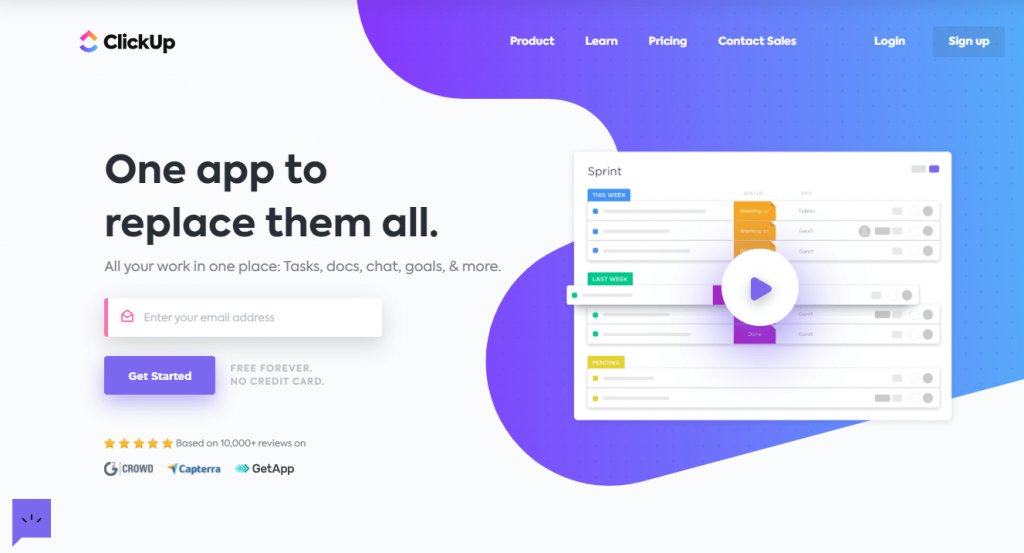
ClickUp is a powerful productivity tool designed to streamline task management and enhance collaboration for individuals and teams. With its wide range of features and intuitive interface, ClickUp helps users stay organised, improve productivity, and achieve their goals efficiently.
At its core, ClickUp provides a centralised platform for managing tasks, projects, and workflows. Users can create tasks, assign them to team members, set due dates, and track progress. The tool offers various task views, such as lists, boards, and timelines, allowing users to visualise and manage their work in a way that suits their preferences.
One of ClickUp's standout features is its customisable hierarchy structure. Users can create spaces to represent different teams, departments, or projects; within each space, they can create multiple folders, lists, and tasks. This hierarchical system helps organise tasks and ensures users can easily navigate their work.
ClickUp also offers robust collaboration features. Users can leave comments, attach files, and discuss directly within tasks, eliminating the need for scattered communication channels. Additionally, ClickUp supports integrations with widespread communication and file-sharing tools, enabling seamless collaboration across platforms.
The platform further enhances productivity through automation and workflow management. ClickUp allows users to create custom automation rules to automate repetitive tasks and notifications, saving time and reducing manual effort. It also provides advanced features like time tracking, Gantt charts, and resource management, enabling users to plan and allocate resources effectively.
In addition to its core functionalities, ClickUp provides a wide range of additional features and integrations to enhance productivity. These include goal tracking, document management, mind maps, and more. ClickUp offers a robust API and integrates with numerous third-party applications, enabling users to connect their favourite tools and streamline their workflows.
26 – Asana
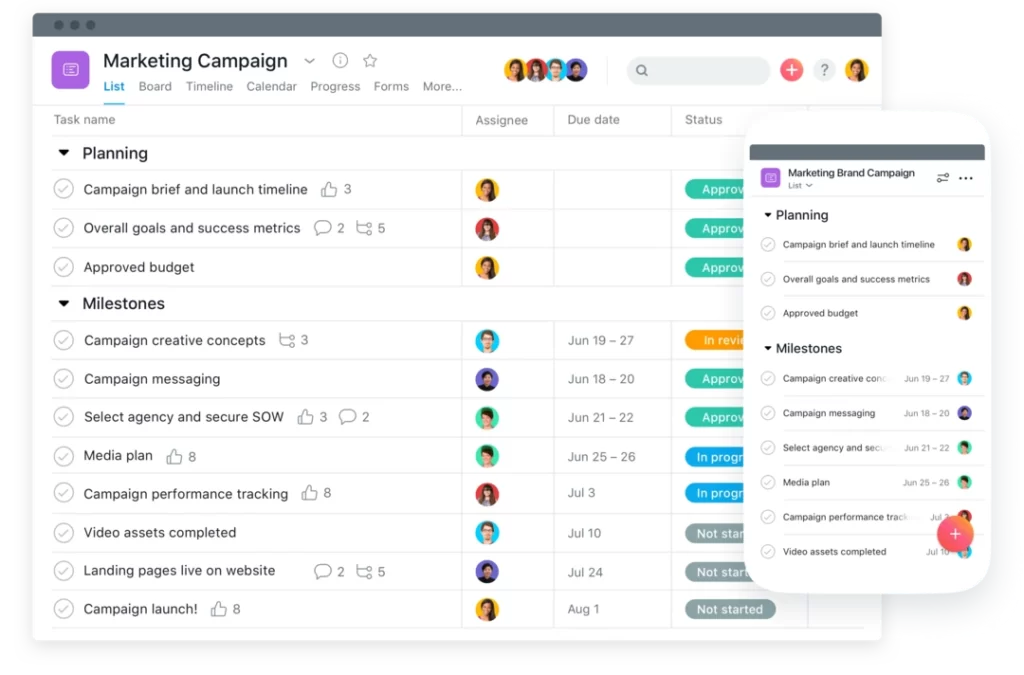
Asana is a highly effective productivity tool designed to help individuals and teams manage projects and tasks efficiently. With its user-friendly interface and robust feature set, Asana has become famous for organising and collaborating on work across various industries.
One of the core features of Asana is its task management system. Users can create tasks, assign them to team members, set due dates, and track progress. This allows for clear visibility into who is responsible for what and when it needs to be completed. Tasks can be organised into projects, making grouping related activities easier and streamlining workflows.
Asana also offers a range of collaboration tools. Team members can leave comments, attach files, and discuss directly within tasks, eliminating the need for lengthy email threads. Notifications and activity feeds keep everyone updated on real-time project developments, fostering better communication and alignment.
To enhance productivity, Asana provides customisable project views. Users can choose between list, board, calendar, and timeline views, depending on their preference and the nature of the project. This flexibility allows for personalised workflows and improved project visibility.
Furthermore, Asana integrates with popular tools such as Google Drive, Slack, and Dropbox, enabling seamless information sharing and file management. The platform also offers advanced features like dependencies, which allow users to establish task relationships and ensure a smooth workflow.
27 – Google Drive

Google Drive is a versatile and powerful productivity tool that provides users with a secure and accessible platform for creating, storing, and sharing various types of files. It is an integral part of the Google Workspace suite of applications and offers a range of features that enhance collaboration and organisation.
At its core, Google Drive is a cloud storage service that enables users to store and access files from any device with an internet connection. It provides 15 GB of free storage and allows users to purchase additional storage if needed. Files stored on Google Drive can be accessed from a web browser or through dedicated Windows, macOS, Android, and iOS applications.
One of the standout features of Google Drive is its collaboration capabilities. Multiple users can simultaneously work on a single document, spreadsheet, or presentation, making real-time edits and comments. This promotes seamless teamwork and eliminates the need for version control issues. Additionally, users can easily share files and folders with specific individuals or groups, granting them varying access levels, such as view-only or editing permissions.
Google Drive supports many file formats, including documents, spreadsheets, presentations, images, audio, and video files. It seamlessly integrates with other Google Workspace applications, such as Google Docs, Sheets, and Slides, allowing for efficient editing and synchronisation. The built-in search functionality makes locating files by name, content, or even metadata effortless.
Moreover, Google Drive offers powerful file management features. Users can organise files into folders, apply labels and tags, and create custom hierarchies. It also provides automatic file syncing across devices, ensuring that the latest versions of files are accessible everywhere.
28 – Notion
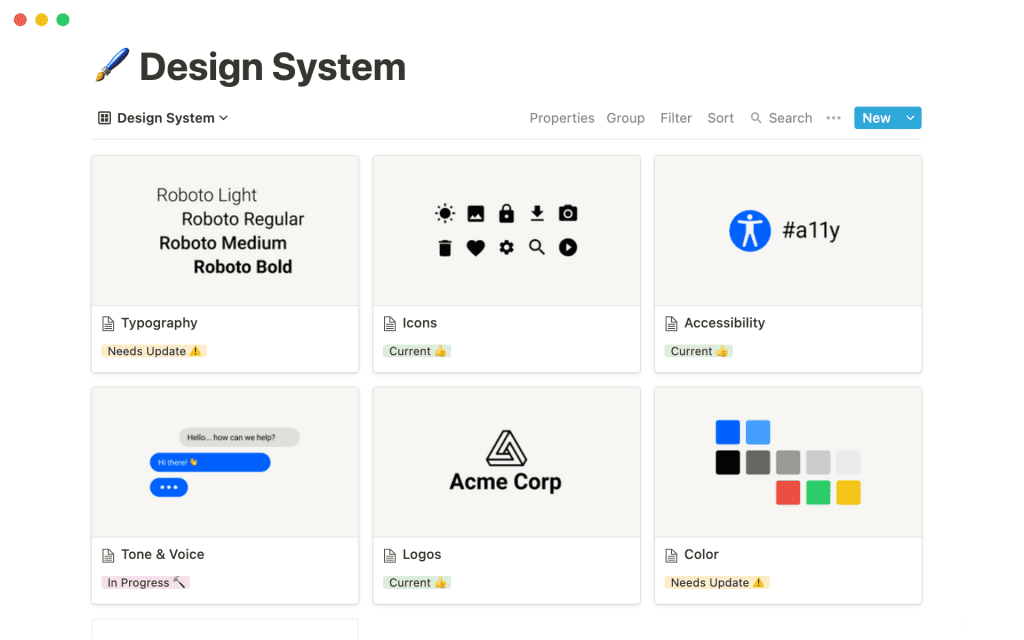
Notion is a versatile productivity tool that combines the functions of note-taking, project management, database organisation, and collaboration in a single platform. With its intuitive interface and powerful features, Notion empowers individuals, teams, and organisations to streamline workflows and enhance productivity.
At its core, Notion offers a flexible and customisable workspace where users can create and organise content using blocks. These blocks can be text, images, videos, files, or embedded links, allowing dynamic and interactive note-taking. Users can hierarchically arrange these blocks, creating pages, subpages, and databases that suit their needs.
One of Notion's standout features is its database functionality. Users can create databases to store and manage various types of information, such as tasks, contacts, or project details. These databases can be customised with different properties, filters, and views, enabling efficient data organisation and retrieval. The notion also provides powerful collaboration tools, allowing multiple users to work together in real time, comment on pages, and assign tasks to individuals or teams.
Notion's versatility extends further with its template gallery. It offers various pre-designed templates, including project management, goal tracking, meeting notes, etc. Users can also create their own templates, allowing for personalised workflows and efficient replication of structures for recurring tasks.
Notion integrates seamlessly with other popular productivity tools and services, such as Google Drive, Trello, and Slack, expanding its functionality and ensuring compatibility with existing workflows.
29 – Draftable

Draftable is an innovative and powerful online tool that compares PDFs with efficiency and accuracy. It's particularly valuable for professionals who must compare legal PDFs, such as lawyers, paralegals, and business analysts. The tool operates seamlessly across different browsers and requires no downloads or installations, making it convenient for users on the go.
One of Draftable's standout features is its intuitive user interface. Users can effortlessly upload PDFs and initiate comparisons with just a few clicks. The side-by-side layout of the documents allows for quick visual inspection, highlighting the differences between the texts and ensuring that no essential details are overlooked.
Draftable employs advanced algorithms that ensure precise comparison, even with complex PDF documents. It maintains formatting, layouts, and fonts, accurately representing the changes between versions. This precision is particularly crucial when dealing with legal documents, where minor discrepancies can have significant implications.
The security of documents is a priority in Draftable. Users can trust that their confidential information is protected with robust encryption and strict privacy policies. Files are automatically deleted from the servers after a specific period, providing an additional layer of security.
Integration with popular platforms and the availability of a desktop version make Draftable a versatile tool for various users. Whether comparing contracts, agreements, or other essential documents, Draftable simplifies the process, saving time and reducing potential errors.
Draftable's capability to compare legal PDFs efficiently places it among the best web tools for professionals across diverse industries. Its user-friendly interface, accurate comparison algorithms, and steadfast commitment to security make it a preferred choice for those seeking a reliable and convenient solution for comparing PDFs online.
Security and Performance Tools:
30 – Bitwarden

Bitwarden is a powerful password management tool designed to protect users' digital identities and enhance online security. It offers many features to streamline password management and promote strong security practices.
At its core, Bitwarden is a secure vault to store and organise passwords. Users can generate strong, unique passwords for every account and securely store them in their Bitwarden vault. The tool provides cross-platform compatibility, allowing access to passwords from desktops, laptops, smartphones, and web browsers.
Bitwarden employs end-to-end encryption, ensuring passwords and sensitive data are encrypted on the user's device and remain encrypted even during transmission to the cloud servers. This means only the user can access their data, as Bitwarden has zero knowledge about the vault's contents.
The tool offers a user-friendly interface, allowing users to add, edit, and delete passwords quickly. It supports autofill functionality, seamlessly filling in login credentials for websites and applications, saving time and reducing the risk of password reuse.
Bitwarden also includes features like secure password sharing, allowing users to share passwords with trusted individuals without compromising security. It supports two-factor authentication (2FA), adding an extra layer of protection to the vault and ensuring that only authorised users can access the account.
Furthermore, Bitwarden supports secure notes and file attachments, enabling users to store sensitive information beyond passwords. It also offers a password generator, which suggests strong, randomised passwords based on user-defined parameters.
31 – Cloudflare
Cloudflare is a prominent cloud-based security and performance enhancement platform that acts as a protective shield between websites and potential online threats. It offers a suite of features to safeguard websites from attacks and optimise their performance.
One of the primary features of Cloudflare is its distributed denial-of-service (DDoS) mitigation capability. It employs a global network of servers to absorb and filter out malicious traffic, ensuring that websites remain accessible and functional during DDoS attacks. This protection extends to multiple DDoS attacks, including volumetric, application layer, and DNS amplification attacks.
Cloudflare also provides a web application firewall (WAF) that detects and blocks suspicious traffic, protecting websites from common vulnerabilities like SQL injection and cross-site scripting attacks. The WAF employs rule sets and customisable security policies to identify and mitigate potential threats in real-time.
Additionally, Cloudflare offers secure content delivery network (CDN) services, caching static content across its global network of servers to accelerate website loading times. Caching content closer to end-users reduces latency and improves overall website performance.
Another notable feature is SSL/TLS encryption, which encrypts the communication between websites and visitors, safeguarding sensitive information from interception and ensuring data privacy.
Cloudflare also provides DNS management services, allowing users to manage and optimise their DNS records. With their authoritative DNS service, Cloudflare aims to provide fast, reliable, and secure DNS resolution.
Furthermore, Cloudflare offers analytics and logging capabilities, enabling users to gain insights into their website's traffic, security events, and performance metrics.
Wrapping up the Best Web Tools List
This blog post explored over 30 of the best web tools available today, each with unique features and benefits.
From project management to time tracking, communication to design, these tools have revolutionised how we work and collaborate. They have empowered individuals, teams, and businesses to streamline processes, save time, and achieve remarkable results.
Whether you're a freelancer, entrepreneur, student, or professional, there's a web tool on this list to suit your needs. The options are abundant whether you're looking for a comprehensive toolset or a specialised solution. These tools offer intuitive interfaces, robust functionalities, and seamless integration, ensuring a seamless user experience.
By leveraging these web tools, you can enhance your efficiency, stay organised, and overcome the challenges of our fast-paced digital world. With features like task management, file sharing, team collaboration, and automation, you can optimise your workflow and focus on what truly matters—creating, innovating, and achieving your goals.
Remember, the key is not just accumulating many tools but choosing the ones that align with your specific requirements and working style. Experiment, explore, and find the perfect combination that empowers you to achieve your full potential.
As we embrace the power of these web tools, let us also remember the importance of balance and mindful technology use. While these tools can amplify our productivity, taking breaks, disconnecting, and nurturing our well-being is crucial. Ultimately, technology should serve as a tool to enhance our lives, not control them.
So, dive into this vibrant ecosystem of web tools, embrace the possibilities, and embark on a journey of increased productivity, efficiency, and success. Your digital toolbox is ready to empower you and transform how you get things done.
